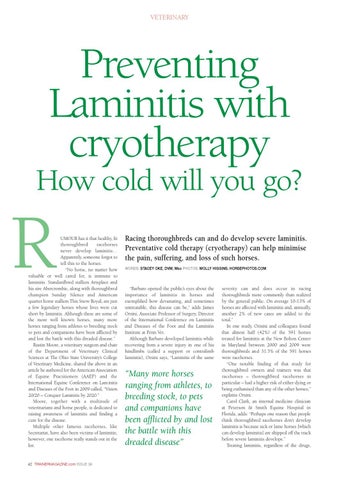LAMINITIS ISSUE 39_Jerkins feature.qxd 20/08/2012 09:34 Page 1
VETERINARY
Preventing Laminitis with cryotherapy
How cold will you go?
R
UMOUR has it that healthy, fit thoroughbred racehorses never develop laminitis… Apparently, someone forgot to tell this to the horses. “No horse, no matter how valuable or well cared for, is immune to laminitis. Standardbred stallion Artsplace and his sire Abercrombie, along with thoroughbred champion Sunday Silence and American quarter horse stallion This Snow Royal, are just a few legendary horses whose lives were cut short by laminitis. Although these are some of the more well known horses, many more horses ranging from athletes to breeding stock to pets and companions have been afflicted by and lost the battle with this dreaded disease.” Rustin Moore, a veterinary surgeon and chair of the Department of Veterinary Clinical Sciences at The Ohio State University’s College of Veterinary Medicine, shared the above in an article he authored for the American Association of Equine Practitioners (AAEP) and the International Equine Conference on Laminitis and Diseases of the Foot in 2009 called, “Vision 20/20 – Conquer Laminitis by 2020.” Moore, together with a multitude of veterinarians and horse people, is dedicated to raising awareness of laminitis and finding a cure for the disease. Multiple other famous racehorses, like Secretariat, have also been victims of laminitis; however, one racehorse really stands out in the list.
42 TRAINERMAGAZINE.com ISSUE 39
Racing thoroughbreds can and do develop severe laminitis. Preventative cold therapy (cryotherapy) can help minimise the pain, suffering, and loss of such horses. WORDS: STACEY OKE, DVM, Msc PHOTOS: MOLLY HIGGINS, HORSEPHOTOS.COM
“Barbaro opened the public’s eyes about the importance of laminitis in horses and exemplified how devastating, and sometimes untreatable, this disease can be,” adds James Orsini, Associate Professor of Surgery, Director of the International Conference on Laminitis and Diseases of the Foot and the Laminitis Institute at Penn Vet. Although Barbaro developed laminitis while recovering from a severe injury in one of his hindlimbs (called a support or contralimb laminitis), Orsini says, “Laminitis of the same
“Many more horses ranging from athletes, to breeding stock, to pets and companions have been afflicted by and lost the battle with this dreaded disease”
severity can and does occur in racing thoroughbreds more commonly than realized by the general public. On average 10-13% of horses are affected with laminitis and, annually, another 2% of new cases are added to the total.” In one study, Orisini and colleagues found that almost half (42%) of the 591 horses treated for laminitis at the New Bolton Center in Maryland between 2000 and 2009 were thoroughbreds and 31.3% of the 591 horses were racehorses. “One notable finding of that study for thoroughbred owners and trainers was that racehorses – thoroughbred racehorses in particular – had a higher risk of either dying or being euthanised than any of the other horses,” explains Orsini. Carol Clark, an internal medicine clinician at Peterson & Smith Equine Hospital in Florida, adds: “Perhaps one reason that people think thoroughbred racehorses don’t develop laminitis is because sick or lame horses [which can develop laminitis] are shipped off the track before severe laminitis develops.” Treating laminitis, regardless of the drugs,
